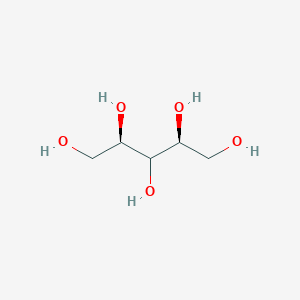| General Information of MET (ID: META00493) |
| Name |
D-Xylitol
|
| Synonyms |
Click to Show/Hide Synonyms of This Metabolite
(2R,3R,4S)-Pentane-1,2,3,4,5-pentaol; D-XYLITOL; Xylit; Xylite; Xylitol; xylo-Pentitol
|
| Source |
Food;Plant;Metabolite;Yeast Metabolite;Food;Cosmetic;Food additives;Plant Metabolite; Microbial
|
| Structure Type |
Carbohydrates and carbohydrate conjugates (Click to Show/Hide the Complete Structure Type Hierarchy)
Organic oxygen compounds
Organooxygen compounds
Carbohydrates and carbohydrate conjugates
|
| PubChem CID |
|
| HMDB ID |
|
| Formula |
C5H12O5
|
| Structure |
<iframe style="width: 300px; height: 300px;" frameborder="0" src="https://embed.molview.org/v1/?mode=balls&cid=6912"></iframe>
|
 |
|
3D MOL
|
2D MOL
|
|
Click to Show/Hide the Molecular/Functional Data (External Links/Property/Function) of This Metabolite
|
| KEGG ID |
|
| DrugBank ID |
|
| ChEBI ID |
|
| FooDB ID |
|
| ChemSpider ID |
|
| Physicochemical Properties |
Molecular Weight |
152.15 |
Topological Polar Surface Area |
101 |
| XlogP |
-2.5 |
Complexity |
76.1 |
| Heavy Atom Count |
10 |
Rotatable Bond Count |
4 |
| Hydrogen Bond Donor Count |
5 |
Hydrogen Bond Acceptor Count |
5 |
| Function |
Xylitol is a five-carbon sugar alcohol that is obtained through the diet. It is not endogenously produced by humans. Xylitol is used as a diabetic sweetener which is roughly as sweet as sucrose with 33% fewer calories. Xylitol is naturally found in many fruits (strawberries, plums, raspberries) and vegetables (e.g. cauliflower). Because of fruit and vegetable consumption the human body naturally processes 15 grams of xylitol per day. Xylitol can be produced industrially starting from primary matters rich in xylan which is hydrolyzed to obtain xylose. It is extracted from hemicelluloses present in the corn raids, the almond hulls or the barks of birch (or of the by-products of wood: shavings hard, paper pulp). Of all polyols, it is the one that has the sweetest flavor (it borders that of saccharose). It gives a strong refreshing impression, making xylitol an ingredient of choice for the sugarless chewing gum industry. In addition to his use in confectionery, it is used in the pharmaceutical industry for certain mouthwashes and toothpastes and in cosmetics (creams, soaps, etc.). Xylitol is produced starting from xylose, the isomaltose, by enzymatic transposition of the saccharose (sugar). Xylitol is not metabolized by cariogenic (cavity-causing) bacteria and gum chewing stimulates the flow of saliva; as a result, chewing xylitol gum may prevent dental caries. Chewing xylitol gum for 4 to 14 days reduces the amount of dental plaque. The reduction in the amount of plaque following xylitol gum chewing within 2 weeks may be a transient phenomenon. Chewing xylitol gum for 6 months reduced mutans streptococci levels in saliva and plaque in adults. Studies have also shown xylitol chewing gum can help prevent acute otitis media (ear aches and infections) as the act of chewing and swallowing assists with the disposal of earwax and clearing the middle ear, while the presence of xylitol prevents the growth of bacteria in the eustachian tubes. Xylitol is well established as a life-threatening toxin to dogs. The number of reported cases of xylitol toxicosis in dogs has significantly increased since the first reports in 2002. Dogs that have ingested foods containing xylitol (greater than 100 milligrams of xylitol consumed per kilogram of bodyweight) have presented with low blood sugar (hypoglycemia), which can be life-threatening. Xylitol is found to be associated with ribose-5-phosphate isomerase deficiency, which is an inborn error of metabolism.
|
|
Regulatory Network
|
|
|
|
|
|
|
|
|
 click to show the details of this protein
click to show the details of this protein
 click to show the details of experiment for validating this pair
click to show the details of experiment for validating this pair
 click to show the details of this protein
click to show the details of this protein
 click to show the details of experiment for validating this pair
click to show the details of experiment for validating this pair

